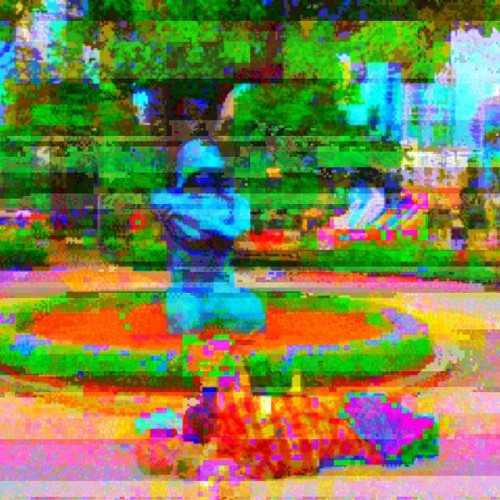FBI director James B. Comey’s recent comment that police scrutiny has led to an uptick in violence is a villainization of #BlackLivesMatter activists. I rerun this piece as a response to Comey’s position.
I am an invisible man. No, I am not a spook like those who haunted Edgar Allan Poe; nor am I one of your Hollywood-movie ectoplasms. I am a man of substance, of flesh and bone, fiber and liquids — and I might even be said to possess a mind. I am invisible, understand, simply because people refuse to see me. Like the bodiless heads you see sometimes in circus sideshows, it is as though I have been surrounded by mirrors of hard, distorting glass. When they approach me they see only my surroundings, themselves, or figments of their imagination — indeed, everything and anything except me…It is sometimes advantageous to be unseen, although it is most often rather wearing on the nerves. Then too, you’re constantly being bumped against by those of poor vision…It’s when you feel like this that, out of resentment, you begin to bump people back. And, let me confess, you feel that way most of the time. You ache with the need to convince yourself that you do exist in the real world, that you’re a part of all the sound and anguish, and you strike out with your fists, you curse and you swear to make them recognize you. And, alas, it’s seldom successful… ~Ralph Ellison (1932), Invisible Man
In what follows, I argue that the Black Lives Matter movement is a hacker group, glitching the social program in ways that disrupt white supremacy with glimpses of race consciousness. It is a group that combats black Americans’ invisibility; that “bumps back” until finally, they are recognized. As Ellison continues:
Invisibility, let me explain, gives one a slightly different sense of time, you’re never quite on the beat. Sometimes you’re ahead and sometimes behind. Instead of the swift and imperceptible flowing of time, you are aware of its nodes, those points where time stands still or from which it leaps ahead. And you slip into the breaks and look around.
The Black Lives Matter movement brings us, forcefully, into the “breaks,” and invites us to look around, too.
To hack is to find and exploit the weaknesses in a system. Once found, hackers can gain access to what’s inside, and, if desired, change the programming. The Black Lives Matter movement is working to accomplish the latter. They expose racism among America’s most established institutions, and then disrupt the fabric of everyday life to bring these weaknesses to the attention of the masses. This disruption or “glitch” that activists—especially activists of color— present is in many cases, simply themselves. They are black bodies taking up space; black bodies making demands; black bodies resisting invisibility.
Earlier this year, Black Lives Matter activists took over Baltimore. Sitting peacefully, marching the streets, and alternatively, breaking windows and setting things on fire in protest of the deadly police brutality inflicted upon Freddie Gray. Police deployed tanks. Officials closed schools. Businesses were unable to operate. Glitch: Look at us.
In Ferguson earlier this week, Black Lives Matter activists blocked the entrance to the St. Louis Federal Courthouse and traffic on a major highway in protest and remembrance of Michael Brown, the unarmed black teen killed by a white police officer one year ago. The city declared a stated of emergency and arrested close to 60 protesters, including high profile activists like philosopher Cornel West. Glitch: We are still here.

In Seattle last week, two black women activists stormed the stage at the Social Security Works rally in Westlake Park, prohibiting white presidential candidate Bernie Sanders from speaking. Lamenting Sanders’ failure to address contemporary racial issues, the women were booed by the crowd but refused to give the microphone back. They invited Sanders to respond to their criticisms. He declined. Following the event, Black Lives Matter Seattle released a press statement in which they proclaim: “…we honor Black lives lost by doing the unthinkable, the unapologetic, and the unrespectable.”
The choice of Sanders as a target is of particular relevance. Sanders is a self-described ally with a strong record of civil rights activism. In fact, just hours after his failed attempt to speak at Westlake, Sanders addressed a crowd of 15,000 at the University of Washington calling for an end to institutional racism and reform of the criminal justice system. In contrast, Donald Trump claims there will be no “black presidents for awhile” following what he considers a botched job by Barack Obama, and Ben Carson believes we needn’t think of race because he knows deep down that brains, not skin, make us who we are.
Bernie isn’t perfect, but he’s far better than the rest. And that’s just it. His work, his almost anti-racist position, his good intentions and barely missed marks make him the lowest common denominator within the existing political system. This is a system that puts black lives alongside a suit of issues—environment, economy, tax policy, military funding. This is a system that hides race issues amongst the crowded tabs of candidates’ official web pages. The Black Lives Matter movement rejects this model. Instead, it insists that in this moment, Black Lives take center stage. Anywhere but the center is unacceptable. No more hiding in plain site. Glitch: We are taking over the platform.
Because of this insistence upon centrality, Black Lives Matter refuses to be Anonymous. They do not disrupt the system quietly. The hack is their presence. The hack is their voices. The hack is their faces. It’s not about discourse or even policy, but an insistence upon visibility; a refusal to remain unseen.
Like any good systems maintenance crew, however, the U.S. social system has workers diligently laboring to quiet the glitches, to restore the program, to punish the hackers and reinstate their invisibility. In Ferguson last year, these workers made up the grand jury that chose not to indict police officer Darren Wilson, the man who killed Michael Brown. This week, the workers are the “Oath Keepers,” made up of five white men with weapons, patrolling the streets of Ferguson to maintain “order” and “peace.” In the media, these are the news stations that label protestors “rioters” and highlight the destruction of property while marginalizing the historical and systemic destruction of black lives. It is Bernie Sanders, who pouts at his lost stage time rather than step aside to graciously acknowledge that this moment is not for him.
But the Back Lives Matter hack is powerful in its persistence. The system has been weakened by cameras on cops, fires in the streets, citizens demanding answers, and feet stomping on the ground, day after day, month after month. And because of this persistence, it is a hack that the system can only fight for so long. Each protest-induced glimpse makes invisibility more difficult to restore. At some point, we will have all seen too much, even those who try to close their eyes. This war of glitches creates a tumultuous moment, but provides the code with which to write an alternative future.
Jenny Davis is on Twitter @Jenny_L_Davis
Headline Pic via: Source

